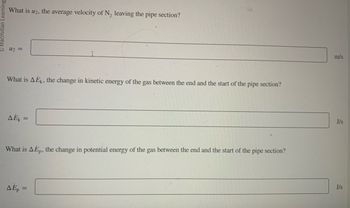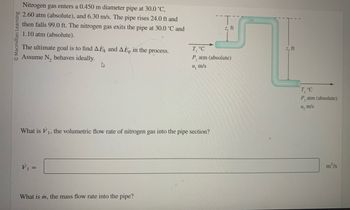
Elements Of Electromagnetics
7th Edition
ISBN: 9780190698614
Author: Sadiku, Matthew N. O.
Publisher: Oxford University Press
expand_more
expand_more
format_list_bulleted
Question

Transcribed Image Text:Learning
What is u₂, the average velocity of N₂ leaving the pipe section?
U₂ =
What is AEk, the change in kinetic energy of the gas between the end and the start of the pipe section?
AEK =
What is A Ep, the change in potential energy of the gas between the end and the start of the pipe section?
AEp =
m/s
J/s
J/s

Transcribed Image Text:© Macmillan Learning
Nitrogen gas enters a 0.450 m diameter pipe at 30.0 °C,
2.60 atm (absolute), and 6.30 m/s. The pipe rises 24.0 ft and
then falls 99.0 ft. The nitrogen gas exits the pipe at 30.0 °C and
1.10 atm (absolute).
The ultimate goal is to find AEK and AĖp in the process.
Assume N₂ behaves ideally.
What is V₁, the volumetric flow rate of nitrogen gas into the pipe section?
1,
V₁ =
What is m, the mass flow rate into the pipe?
z, ft
T, °C
P, atm (absolute)
u, m/s
z, ft
T, °C
P, atm (absolute)
u₂ m/s
m³/s
Expert Solution
This question has been solved!
Explore an expertly crafted, step-by-step solution for a thorough understanding of key concepts.
Step by stepSolved in 3 steps with 1 images

Knowledge Booster
Learn more about
Need a deep-dive on the concept behind this application? Look no further. Learn more about this topic, mechanical-engineering and related others by exploring similar questions and additional content below.Similar questions
- Liquid nitrogen has a density of 0.808 g/mL and boils at 77 K. Researchers often purchase liquid nitrogen in insulated 175-L tanks. The liquid vaporizes quickly to gaseous nitrogen (which has a density of 1.15 g/L at room temperature and atmospheric pressure) when the liquid is removed from the tank. Suppose that all 175 L of liquid nitrogen in a tank accidentally vaporized in a lab that measured 10.00m x 10.00m x 2.50m. What maximum fraction of the air in the room could be displaced by the gaseous nitrogen?arrow_forwardProcess 0-4 is an adiabatic process as shown. Which of the followings is true? Select all apply. -Isotherms →V O AEth is positive O AEth is negative O AE+H is zero Wby gas is positive Wby gas is negative Wby gas is zero O Q is positive O Q is negative Q is zeroarrow_forwardConcept related to the Joule Thomson effect. Handwritten solution allowed.arrow_forward
- Question 2. Solve with detailed solutions please. Thank Youarrow_forwardYou have a tank that is 0.01 m^3 and is initially evacuated. You then hook this up to a line that supplies N2 at a pressure of P_1 = 5 bar and a T_1 = 350 K. The tank fills adiabatically (you can assume there is no heat flow to the walls of the tank), and the filling ends when no more N2 flows into the tank. Find a) the final pressure of the gas in the tank, and b) the final temperature of the gas in the tank. You can assume N2 is an ideal gas with a CP* = 29 J/mol K. NOTE: Mainly I am confused on how the evacuated tank factors into the work for b). What I did was use the ideal gas formula to find a value for N2*T2 (601.395) but I am no longer certain how to continue in the work. I was assuming the practice question had meant the temperature of the tank was 0 initially but it leads to a negative mole value. For a) I got 5 bar, arguing the flow would stop when the pressure of tank and line are equalarrow_forward
arrow_back_ios
arrow_forward_ios
Recommended textbooks for you
 Elements Of ElectromagneticsMechanical EngineeringISBN:9780190698614Author:Sadiku, Matthew N. O.Publisher:Oxford University Press
Elements Of ElectromagneticsMechanical EngineeringISBN:9780190698614Author:Sadiku, Matthew N. O.Publisher:Oxford University Press Mechanics of Materials (10th Edition)Mechanical EngineeringISBN:9780134319650Author:Russell C. HibbelerPublisher:PEARSON
Mechanics of Materials (10th Edition)Mechanical EngineeringISBN:9780134319650Author:Russell C. HibbelerPublisher:PEARSON Thermodynamics: An Engineering ApproachMechanical EngineeringISBN:9781259822674Author:Yunus A. Cengel Dr., Michael A. BolesPublisher:McGraw-Hill Education
Thermodynamics: An Engineering ApproachMechanical EngineeringISBN:9781259822674Author:Yunus A. Cengel Dr., Michael A. BolesPublisher:McGraw-Hill Education Control Systems EngineeringMechanical EngineeringISBN:9781118170519Author:Norman S. NisePublisher:WILEY
Control Systems EngineeringMechanical EngineeringISBN:9781118170519Author:Norman S. NisePublisher:WILEY Mechanics of Materials (MindTap Course List)Mechanical EngineeringISBN:9781337093347Author:Barry J. Goodno, James M. GerePublisher:Cengage Learning
Mechanics of Materials (MindTap Course List)Mechanical EngineeringISBN:9781337093347Author:Barry J. Goodno, James M. GerePublisher:Cengage Learning Engineering Mechanics: StaticsMechanical EngineeringISBN:9781118807330Author:James L. Meriam, L. G. Kraige, J. N. BoltonPublisher:WILEY
Engineering Mechanics: StaticsMechanical EngineeringISBN:9781118807330Author:James L. Meriam, L. G. Kraige, J. N. BoltonPublisher:WILEY

Elements Of Electromagnetics
Mechanical Engineering
ISBN:9780190698614
Author:Sadiku, Matthew N. O.
Publisher:Oxford University Press

Mechanics of Materials (10th Edition)
Mechanical Engineering
ISBN:9780134319650
Author:Russell C. Hibbeler
Publisher:PEARSON

Thermodynamics: An Engineering Approach
Mechanical Engineering
ISBN:9781259822674
Author:Yunus A. Cengel Dr., Michael A. Boles
Publisher:McGraw-Hill Education

Control Systems Engineering
Mechanical Engineering
ISBN:9781118170519
Author:Norman S. Nise
Publisher:WILEY

Mechanics of Materials (MindTap Course List)
Mechanical Engineering
ISBN:9781337093347
Author:Barry J. Goodno, James M. Gere
Publisher:Cengage Learning

Engineering Mechanics: Statics
Mechanical Engineering
ISBN:9781118807330
Author:James L. Meriam, L. G. Kraige, J. N. Bolton
Publisher:WILEY